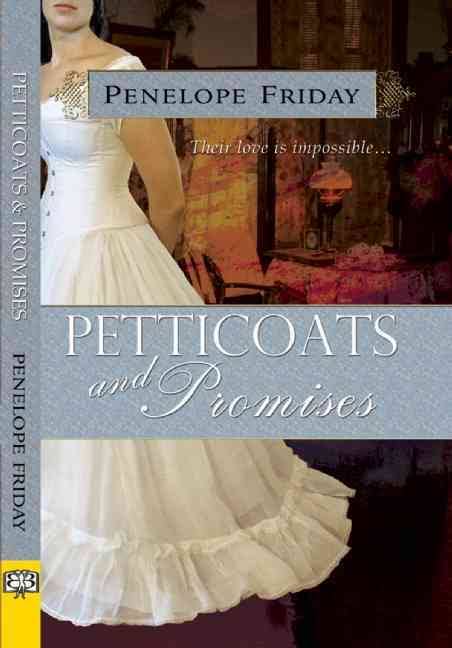I love historical romance novels, especially those featuring women who love women (see Pembroke Park). The high stakes of that love when women could not earn a living and had to secure their livelihoods and social position through strategic marriages automatically creates tension and drama. Petticoats and Promises, a Regency romance by Penelope Friday, is a mostly entertaining read in that genre.
A few weeks before their joint coming out ball, Serena Coleridge is astonished to realize that she is in love for her best friend, Clara Battersley, and that the feeling is mutual. As the young women discuss the fact that their debut is an announcement of availability on the marriage market, Serena confesses that she cannot imagine loving someone as much as she does Clara. Their tête-à-tête is interrupted that afternoon but their feelings do not remain unspoken for long; soon the girls share passionate kisses and sensual encounters. On the eve of their coming out ball, Serena’s father’s stocks plummet, leaving no money for a season. Serena does not mind the loss of the social whirl – she is more concerned about losing access to her beloved. An invitation to visit the Coleridges in London is the perfect excuse for Clara and Serena to be together – until they are caught by Clara’s mother, who sends Serena home in disgrace. The rest of the novel follows the aftermath as Serena is cut off from Clara, who quickly marries; deals with her parents’ sorrow and mortification; and navigates the turbulent waters of society. She is sponsored in town by her Aunt Hester and becomes friends with the awkward but kind Mr. Feverley and Miss Kate Smith, another “invert,” which helps her to heal.
Penelope Friday doesn’t try to imitate Jane Austen (or Georgette Heyer imitating Jane Austen) – she allows Serena Coleridge’s first person narration to render acute observations about social interactions and give readers a glimpse of what life was like in the Regency period. Friday is good at depicting the constraints of the era – never being alone or having time to oneself without servants or parents around, the need to abide by rules and strictures of good breeding. The problem with such insularity, of course, is that the novel focuses solely on Serena’s internal emotional life and yearning for Clara, without the cutting wit and sense of irony that makes Jane Austen’s writing so beloved. Since Clara and Serena share so much history then spend most of the novel apart, it can be difficult to feel invested in them as a couple. The endless misunderstandings between Serena and Clara are another issue with the novel; if only they spoke openly and thoroughly, their happily ever after could have come much sooner. But there is a happily ever after indeed!


Widdershins says
We need more HEA’s 🙂